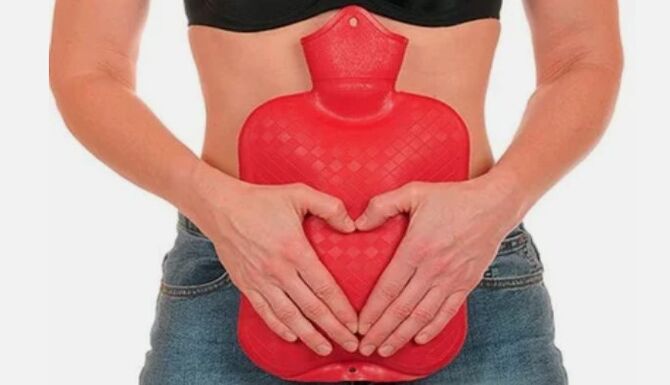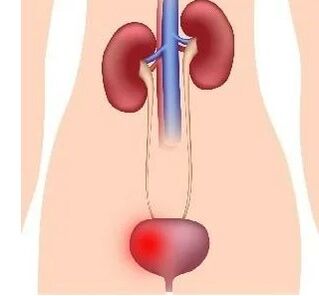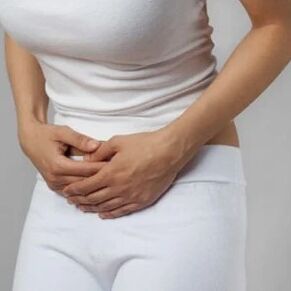Cystitis- This is a pathology, characterized by the development of inflammatory processes that affect the bladder wall due to the effects of bacterial microorganisms.

Statistic Cystitis- One of the most common urological pathologies. Women are more exposed to the occurrence of these inflammation, because of their morphophysiological features.
The bacterial agent enters the bladder cavity in three ways:
- The road- through the urethra (urethra). The main role of the penetration of these microorganisms is the anatomical and morphology of the female urinary tract: short and wide urethra, close to the anus and vagina.
- The way down- from the kidneys. This option develops as a course of kidney inflammation, for example, chronic pyelonephritis.
- Hematogenic pathways- The rarest option is established when cystitis occurs immediately after an infectious disease, or when another source of purulent infection in the female body is detected. There is also the probability of bacterial microflora in the bladder due to the presence of anatomosis anatomosis (extension) between the genital organs and the bladder, subject to changes in inflammation.
The most common causal agent in the process of inflammation of the bladder is E. coli (in 4 out of 5 cases, associated with the above -mentioned anatomical and morphological features in and the presence of these microflora in the intestine).
Less commonly, cystitis is associated with staphylococcal microorganisms, streptococcal and enterokoccal. Grams -Negative unkinds cause bladder inflammation due to instrumental intervention and surgery.
Recently, the occurrence of cystitis is associated with fungal microorganisms, the simplest and the virus has increased.
Only the introduction of infectious microorganisms is not enough for the development of full inflammatory reactions in the bladder, as the body contains a resistance mechanism for pathogenic flora action.
Cystitis development factors
Therefore, in addition to the etiological factors, factors such as ::
- Hemodynamic function impairment(blood circulation) of the pelvic organs and, in particular, the bladder;
- Disruption of the excretion function of the bladder(urine stagnation);
- prevents a variety of body immune relationships(vitamin deficiency, exposure to low temperature, pressure, increased fatigue, etc. );
- Passionate effects of biochemical agentsand exchange products released in urine to the structure of the bladder wall;
- exposure to radiological radiation;
- does not fit the cleanlinessexternal genitals and random sexual relations;
- the pathology of the gastrointestinal tract, in front of it microflora accumulates and increases its activities, which then enter the urinary tract;
- Periodic transition of hormone metabolismwhich leads to lack of urethra tone and creates the best condition for infection.

Manifestations of the first symptoms of cystitis in women
Acute cystitis clinic in a woman is characterized by a sudden and complex symptom complexWith:
- Frequent urination appearance (pollakiuria)characterized by frequency at least once every 60 minutes and a small amount of urine is released; With frequent development of impulse, patients are unable to control and maintain urine;
- Dysuria (urinary tract)accompanied by pain in the hypogastric region (in the lower abdomen). With the development of the level of inflammation in the bladder wall, the progress of these symptoms: the more it is developed, the more often the desire to urinate and the more intense pain;
- Itching in the urinary tractarises during urination. Develop due to exposure to mucous membranes of urinary tract metabolism microorganisms that cause bladder inflammation;
- The appearance of blood dropletsAt the end of the Abandonment Act;
- The appearance of the urine, due to the entry of a large number of blood cells (leukocytes and red blood cells), bacterial microflora, cells -epithelial cells in the internal wall of the bladder;
- Such patients are not characterized by changes in general conditions.The patient's temperature indication is characterized by normal or slightly increasing (low graduity). Scientists associate it with the fact that the mucous membranes of the bladder practically do not inhale in metabolic products of microorganisms, which, which enter the blood, usually lead to body intoxication and the development of symptoms of inflammation.
Symptoms connection suddenly -the previous and previous hypothermia of the female body has appeared. The phenomenon of acute inflammation can sometimes be observed for 2-3 days and is free to disappear without the use of therapy.

However, this process usually takes more than 6 days, sometimes up to 15 days. The presence of the disease later, subject to the appointment of therapy, requires the appointment of additional examination methods to identify the pathology of the body.
Characterization of pain with cystitis in women
In patients with acute cystitis, the severity of different pain syndrome is observed:
- In the light process of the inflammatory process, the patient feels severe or unimportant pain in the lower abdomen.Sensitive pain at the end of the Urination Act accompanies a moderate pollakiuria. With further development of the inflammation process, the intensity of the pain increases. Subsequently, this syndrome accompanies the onset or entire urinary tract. The pain became unrelated to the act and obtained almost constant, it was accompanied by a very painful palpation of the bladder projection.
- In situations where heavy cystitis develops, the patient should urinate at least 2-3 times an hour, which is accompanied by significant pain syndrome and the appearance of blood discharge from the urethra at the end of the Act. The pain is worsening the quality of life of the patient, as they are not lost throughout the day.
The presence of blood and blood cells in urine with cystitis (hematuria syndrome)
When the inflammation process develops on the bladder wall, it affects the fabric area near the ureter meeting and out of the urethra. The tissue becomes loose and bleeding.
This is reflected in the appearance of micro and makrohematuria (or blood) in the urine, which is often observed at the end of the abandonment (terminal hematuria).
One of the worst forms of acute cystitis is hemorrhagic. This type of inflammation occurs with significant red blood cells (red blood cells) from the nourishing artery blood flow into the bladder cavity.
This option may occur in the event of blood vessel wall permeability (conditions for anemia, vitamin deficiency, disruption in the operation of the blood system) or damage to the wall above with bacterial cells (usually streptococcal flora). Red blood cells that have fallen into the urine stain bubble in the bloodstream.
When hematuria occurs, doctors are required to be careful to perform the differential diagnostics between acute cystitis and complicated acute forms - hemorrhagic cystitis. For this, additional examination methods are prescribed, the type of lesion is described and the most correct therapy scheme is selected.
Characteristics -Features of acute and chronic cystitis in women
Sharp cystitis
Summarizing the above information, one can distinguish the onset of a sharp disease and the presence of a complex of certain symptoms for acute cystitis:
- frequently urine in small portions,
- Multi -natural pain syndrome,
- itching associated with urine,
- The appearance of blood falls at the end of the act,
- The general state of women unchanged.
With a proper and timely diagnosis, the pathological condition is cured within 6-10 days. In the absence of improvements after the day15 of the disease, it should be considered about chronic inflammation changes.

In addition to hemorrhagic, there are two other forms of complicated course of acute cystitis:
- Gangrenous.Gangrenus forms are rarely found and occur due to impaired blood supply or bladder conservation. Clinically, such cystitis is characterized by urinary tract difficulties, accompanied by pain, high body temperature, pain in the sacred region. This process is very dangerous for the development of awesome complications, such as peritonitis and requires fast steps for treatment.
- Phlegmonous.The shape of the glitter is characterized by significant body intoxication, high body temperature and accompanied by the release of a small urine (oliguria). Urine, with complicated current, has a putrefactive odor, muddy character, formation fibrin fragments, blood mixtures.
The duration of the pathology course in the development of complicated forms increases significantly.
There is another form of cystitis - interstitial.It is characterized by inflammation of all urine bubble membranes. The clinic is dominated by rapid urination, reaching up to 180 times a day, an active complaint of severe pain in the hypogastric region when filling the bladder and regression after the Abandonment Act. The bubble capacity is significantly reduced, resulting in the above symptoms.
Chronic cystitis
Chronic cystitis, in contrast to acute, is rare as the main pathology and in most cases is the secondary complication of the existing pathology of the bladder, kidneys, urethra.
In view of this fact, it is necessary to carefully examine the body for the presence of the above pathological changes, as well as exclude or confirm the original - certain microorganisms - tuberculosis sticks, trichomonas aggression.
Clinically, chronic cystitis is indicated by a continuous course with moderate differences in complaints and clinical analysis of urine, or in recurrent pathology with a severity period (similar to acute cystitis clinic) and complete regression (in the absence of manifestations of pathological processes).
Therefore, the objective manifestation of chronic cystitis is in accordance with the acute process. They relate to the normal protective properties of the body, the etiology of bacterial agents that cause the contagious process, and the severity of the inflammation. Pain, frequent urination, itching, the presence of blood and urine is unclear with continuous courses and in accordance with the acute process of recurrent chronic cystitis.
Due to the wound of the mucous inflammation reaction, edema of all layers of the urinary wall and increased intrapachear pressure creates all conditions for the formation of vesicular-coring reflux, which is the casting fluid from the urinary tract to the ureter (connecting the kidney and the bubble).

Doctors are involved in the confirmation of diagnosis and the purpose of therapy for cystitis.
To properly diagnose the pathology of the inflammation, it is necessary to clearly correct the patient's complaints and its history (which precedes the development of pathology).
Clinical manifestations are relatively specific and instantly show the presence of the disease, however, it is necessary to make a careful diagnosis of all types of cystitis, as well as from other pathologies of the bladder and abdominal organ disease.
From anamnesis, data on stress and low temperature influences, medications taken, and other lesions placed in the pelvic organs and genitourinary systems, will be useful.
After explaining the complaints and anamnesis, clinical urine analysis (general) will be able to assist in the confirmation of the diagnosis - an increase in white and red blood cell levels will be detected (leukocytes and red blood cells).
To identify the types of bacterial microorganisms that cause inflammation, urine inculcates special nutrient media, which can be used in the future to choose the most effective antibacterial drug.
Before the urine fence for bacteriological examination, it is necessary to qualitatively treat the external genital area with antiseptic solution. Handling cystoscopy with the presence of acute inflammatory reactions is contraindicated.
To diagnose chronic cystitis, together with the collection of complaints and data on anamnesis, cystoscopy helps during forgiveness. This will create all the features that are required for inflammation. With this manipulation, it is possible to take the biopsy-mucous ingredients of the urine. Also, to identify chronic cystitis, the X -Ray study with contrast is recommended.
























